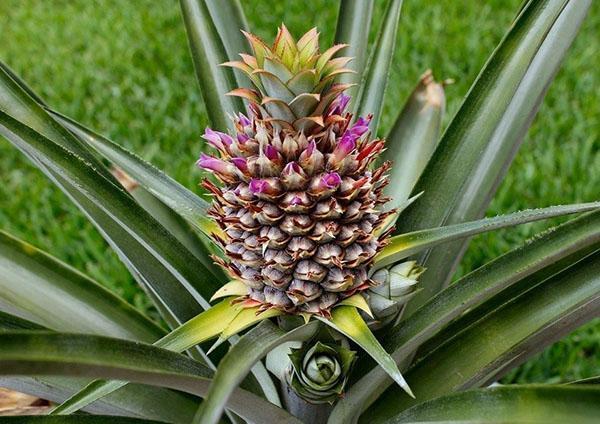Growing pineapple and production of candied fruits from it
 The word "pineapple" comes from the Hawaiian word "Nana", which means "plant", the American name "Pineapple" was given to this fruit by English sailors, who decided that this strange but tasty fruit looks like a giant pine cone.
The word "pineapple" comes from the Hawaiian word "Nana", which means "plant", the American name "Pineapple" was given to this fruit by English sailors, who decided that this strange but tasty fruit looks like a giant pine cone.
How pineapple is grown
For comfortable growth, pineapple needs a temperature of 23ABOUTFrom to 30ABOUTC. Its leafy crown is ideal for harvesting rainwater, and its root system is located almost at the soil surface. Pineapple grows in tropical countries, where it does not rain for several months. Dry weather is even beneficial for the development of pineapple, since at high temperatures the process of photosynthesis proceeds better, which means that the fruit ripens faster.
Healthy a pineapple covered with a thick skin that is dotted with eyes. These eyes are leftovers from pineapple flowers. Each of these reddish-purple flowers forms part of the fruit, then the flowers grow together into one cluster, similar in shape to a pine cone. Thus, a common fetal trunk is formed. During maturation, this trunk thickens, and the flowers fall off. This is how pineapple is formed, because of this it is considered an aggregate fruit.
On plantations, flowering is accelerated by treating the plant with a special gas - ethylene. Such processing makes it possible to harvest the entire fruit crop at the same time.
Pineapple growing is a thorny business, so every plantation worker wears goggles, long sleeves and gloves.
To plant a new field, young pineapple shoots are cut off. Qualified plantation workers determine their quality. Only the finest examples are used to create artificial foliage crowns. Tied bunches of pineapple leaves are graded by weight so that the plants develop evenly. A year after planting the artificial deciduous crown in the ground, the new pineapple will give roots, and after two it will give a new crop.
Candied fruit production
The collected fruits go to the factory, where they undergo a 10-level treatment with chlorinated water. This treatment is done in order to remove small insects and frog eggs from the pineapple. Amphibians love to lay their eggs in pineapple leaves. Next, the fruits are sorted. Class I pineapple must have no more than three damaged eyes. Such fruits are doused with hot wax so that they do not overripe, and sent for export.
Pineapples of the 2nd grade are supplied to the domestic market of the producing country.
The damaged fruit is cleaned and cut into rings, which are placed on large trays. The factory workers then send the pineapples to the oven, where they are dried at 60ABOUTWith a day. After heat treatment, the moisture content of the rings is 6%. Then candied fruits are packed and sent for sale.